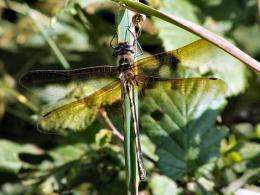Birds could signal mass extinction

(PhysOrg.com) -- The first detailed measurements of current extinction rates for a specific region have shown that birds are the best group to use to track the losses. The study also reveals Britain may be losing species over ten times faster than records suggest, and the speed of loss is probably increasing: the losses from England alone may exceed one species every two weeks.
The study, by Oxford University researchers, shows that many types of obscure organism in Britain are going extinct at the same rate as the birds – evidence supporting fears of a global mass extinction. A report of the research is published in an upcoming issue of the journal Biological Conservation as countries prepare to meet in Japan 18-29 October to discuss biodiversity conservation targets.
‘Biodiversity loss is arguably much more serious and more permanent than climate change,’ said Clive Hambler of Oxford University’s Department of Zoology, lead author of the research. ‘But it's impossible to know if policy targets to reduce the loss are being met without accurate measures of extinction rates. Until now, we had only crude estimates for a very few types of organism. Now we've got evidence that many groups of living things – lichens, bugs, moths, fish, plants and so on - are going extinct at a very similar rate to the birds.’
Using Britain’s uniquely detailed natural history records, the researchers found that 1-5% of the region’s species in many groups were lost since 1800, with higher losses in the Twentieth Century compared to the Nineteenth. Using further data from the USA and across the whole globe, the researchers show that the patterns of extinction in Britain are likely to be typical of those found on land and freshwater elsewhere.
Mr Hambler said: ‘The birds are beautiful creatures, but they are also diverse, and many of them are specialised to particular habitats. This makes them sensitive to changes in their environment – such as loss of mature trees, or the drying out of swampy ground, or coastal development. And what makes them really special for monitoring extinction is that they are also exceptionally easy to study, anywhere in the world – so we can detect declines in their populations long before we notice losses of the more obscure things like slime moulds or mosses. It’s no coincidence they can signal environmental change.’
‘The underlying reason for the similarity of extinction rates in birds and the other living things is that habitat loss affects them in the same way. Our work supports the use of birds to indicate extinction rates in Britain, the USA and globally, and they should now be tried in places such as tropical forests where the bulk of other species will never be recorded.’
‘The recorded extinctions in any region are just the tip of the iceberg, because there are not enough observers,’ said Mr Hambler. For example, in March this year the British government's advisory body, Natural England, reported about 500 species lost from England since 1800. ‘The losses reported by Natural England are under 0.5% per century, from England’s 55,000 species,’ notes Mr Hambler. ‘Our research suggests that the actual losses could be over ten times this number, with about one species going extinct in England every fortnight.’
Natural England also reported species losses in England had apparently declined in recent decades, but the Oxford study suggests that this is not the case. Hambler and colleagues found there are about 1000 endangered species on the brink of extinction in Britain – indeed many of these may already be extinct.
‘People tend to be hesitant in declaring extinction, which leads to problems assessing the current rate,’ said Mr Hambler. ‘Many ancient and important habitats in Britain are threatened today because of human activity and population growth – whether it’s an increase in water use, growing use of wood fuel, or the growth of urban sprawl. Despite conservationists' efforts it's very likely extinction rates will continue to rise in Britain and globally for many years. These losses will impact on human welfare, and I’d say conservation needs a profile and resources even bigger than climate change.’
Alongside studies of birds, the researchers believe that recording rates of habitat loss will provide a good, simple measure of some elements of biodiversity loss.
Mr Hambler said: ‘This work strengthens the claim that the world is suffering a mass extinction. We can now be much more confident that across the planet the less conspicuous and less well-known species are going extinct at a similar high rate to that already witnessed in birds, fish and amphibians.’
Provided by Oxford University














